Anglo-Saxon monarchy
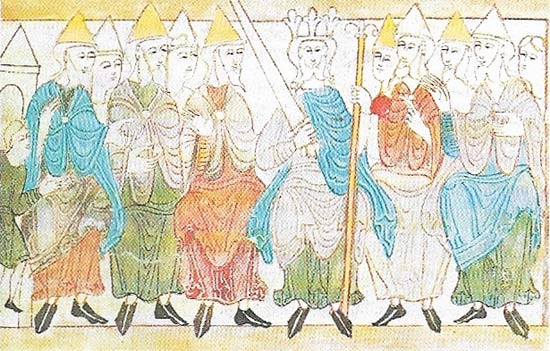
Figure 1. The king and his witan (council) were the ultimate source of justice. The witan comprised the leading churchmen and thegns, or nobles, who were bound to the king by ties of personal loyalty. These formal assemblies developed out of the king's council of the period of Mercian supremacy. They brought problems to the attention of the king and assented to his most important ecclesiastical appointments and land-grants.

Figure 2. Offa's Dyke, running along much of the frontier between Mercia and Wales, testifies to the power of the 8th-century Mercian kings. It was intended more to mark the border than for defense.

Figure 3. The Royal Hall of Cheddar is typical of the halls that were the center of royal power and were the first permanent royal residences. The witan enjoyed the king's hospitality and advised him in such halls.
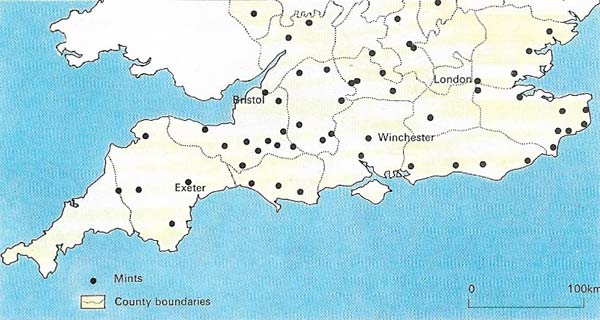
Figure 4. Mints were set up in many towns in the later Anglo-Saxon period. As many as 44 places issued coins during the ten-month reign of Harold in 1066 alone. The king kept strict control over the currency, maintaining the purity of the metal and regularly recalling the entire coinage for reissue, at one time every six years. Although the name of the mint appeared on the coins, the dies were centrally issued. Penalties for counterfeiting included mutilation and death.
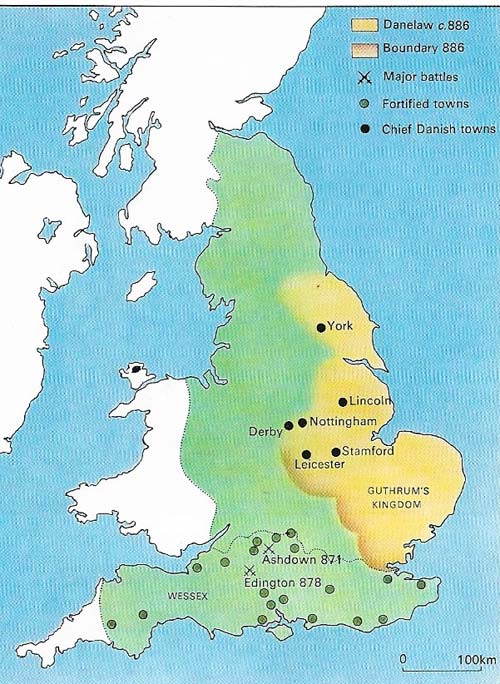
Figure 5. The Danelaw was recognized by King Alfred in the treaty of 886. In the east of the country the Danish traditions of independence and local autonomy continued well into the medieval period. A Viking kingdom was soon established in Lancashire which prevented the Danish expansion to the north.
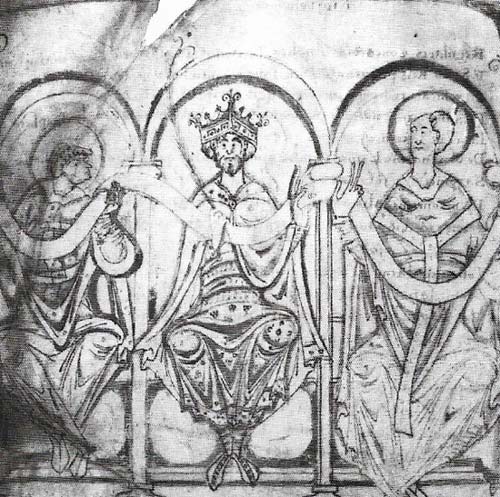
Figure 6. Edgar the Peaceable was a powerful and efficient king who is said to have shown his political authority over the whole of England by being rowed on the River Dee by six sub-kings. He encouraged the monastic revival and this manuscript records his coronation, which took place in 973, two years before he died.
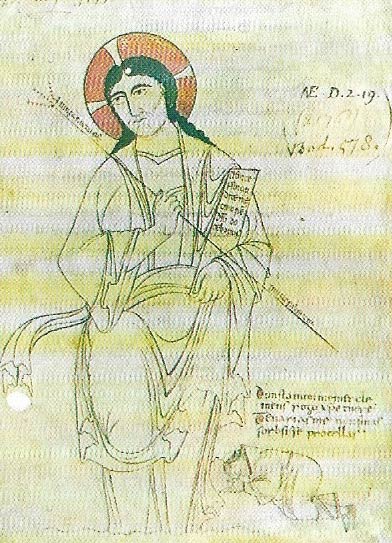
Figure 7. St Dunstan, shown here prostrate at the feet of Christ, was Archbishop of Canterbury from 959 to 988. He promoted the growth of the new monasticism. He founded abbeys at Peterborough and Ely.
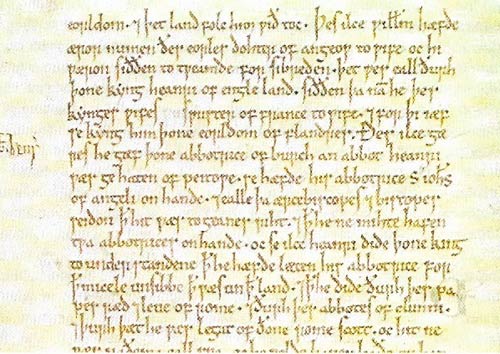
Figure 8. The Anglo-Saxon Chronicle, shown here in the version copied at Peterborough in 1122, is a vital source for knowledge of political history before the Norman Conquest. A collection of genealogies and chronicles prepared by monks, it appeared in a number of different versions. As a result, it is possible to see a regional view of events, as in the case of the crisis of 1051–1052, when the authority of Edward the Confessor (r. 1042–1066) was challenged by the sons of Early Godwin (d. 1053). The Chronicle is said to have been founded by King Alfred as part of his encouragement of English culture.
Between the 7th and 11th centuries, Anglo-Saxon England became a strong and stable nation, organized around a solid and powerful monarchy. This institution developed from that of the warrior chieftain, and throughout the period it continued to rely on the personal relationship of a king with his thegns (Figur 1), to whom he gave lands in exchange for companionship in peace and war, and who had a role, uncertain and fluctuating according to the strength of the previous king, in electing and advising a new monarch. Gradually the king acquired institutional authority through the patronage of the Church and the organization of the currency (5) and, despite the informal nature of much of his authority, he was the hub of the stability and prosperity of the kingdom.
The growth of a unified monarchy
In the eighth century kings of Mercia, in the Midlands, dominated England. The most famous of these was Offa (reigned 757–796), the first king to have personal authority over most of southern England. He wrote a code of laws, set up a stable currency and was a figure of international standing, dealing with Charlemagne on equal terms.
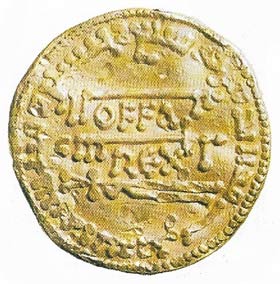 |
| A standardized coinage, based on the silver penny, was introduced by Offa of Mercia, whose name is shown on this coin. It was used for most transactions and was accepted on the Continent. Other coins of Offa copy Arabic models. Offa effectively ended the old heptarchy, or division of England into seven separate kingdoms, even though his immediate successors were unable to maintain the unity that he had created. |
During the early ninth century power passed from Mercia to Wessex, but the first Viking raids, in 793 on the east coast, threatened the stability of England. Sporadic Viking attacks continued until 865, when the "Great Army" chose not to return with its loot to Scandinavia for the winter but instead divided up the land of East Anglia, the East Midlands and Yorkshire, and began to farm it. The English rallied under Alfred (reigned 871–899), king of Wessex, who defeated the Danish commander Guthrum decisively at Edington in 878, and made a treaty confining the Danes to the region east of Watling Street, known as Danelaw (Figure 5). Alfred's son, Edward the Elder (reigned 899–925), reconquered this district by 920, but the substantial numbers of Scandinavian settlers left a permanent mark on social institutions and place names, notably in the suffix "-by", found, for instance, in "Derby". Alfred's daughter, Ethelfleda (died 918) Lady of the Mercians, led campaigns against a new enemy, Norwegian pirates, who attacked the northwest coast, settled in Lancashire, and set up a kingdom in York in 919.
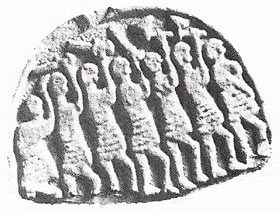 |
| The Vikings raided Lindisfarne monastery in 793, and raids on the east coast for loot continued for 50 years. Most of the surviving accounts of the raids were written by monks, so the Vikings have acquired an image of savagery that ignores the constructive side of their settlement. |
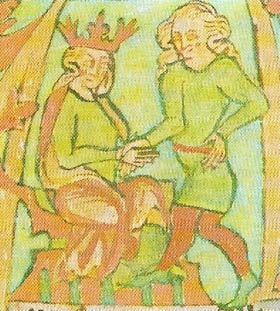 |
| Guthrum (d. 890) is said to have been the first Scandinavian to settle in England. In the treaty of 878 with Alfred he agreed to convert the Danes to Christianity and took the name Athelstan after his own baptism. |
Alfred had organized his defence around burhs (forts), a practice continued in the tenth century. Some of the sites chosen were already towns. The burhs (later called boroughs) became the centres of trade and administration of taxation, and the site of mints (Figure 4), in the late Anglo-Saxon period.
The revival of the monasteries
The Viking attacks had been particularly severe on the wealthy and unprotected monasteries, and had brought the Church to a low ebb by the beginning of the tenth century. A similar decline on the Continent was combated by the reform movement started at the monastery of Cluny in 910. Its ideas were brought to England, about 940, by some English monks who had spent time in the reformed monasteries. Notable among the monks were St Dunstan (c. 925–988) (Figure 7), who revitalized the monastery of Glastonbury, St Ethelwold (c. 908–984), Bishop of Winchester and St Oswald (died 992), Bishop of Worcester. Edgar (944–975), who became king in 959, was an ardent supporter of the monastic revival and was the first king to be crowned with a ceremony that underlined the religious associations of the monarchy [8]. The service, written by St Dunstan, remains the basis for coronation services. The alliance of monasticism with the king gave the ruler a new agency for asserting his authority in the country.
Edgar's son Ethelred II (reigned 978–1016), was again faced with attacks by aggressive Scandinavians. Large taxes, known as Danegeld, were collected to buy off these warbands, so that most of the late Saxon coins still in existence are in the collections of Scandinavian museums. The Danegeld did not prevent the eventual victory of the Danes under Sweyn Forkbeard (died 1014), whose son Canute (994–1035) became king of England in 1016, and of his home country Denmark in 1018.
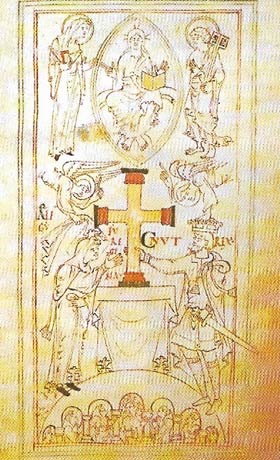 |
| Canute, or Cnut, set up an empire that took in much of the coastlands of the North Sea. As king of England he encouraged the established institutions (here he grants a charter to the New Minster at Winchester with his wife). |
The nature of Anglo-Saxon kingship
The monarchy changed considerably in the course of the period 500–1050. There were, however, some constant themes. The importance of royal blood is emphasized in the early period by genealogies, whose chief function was to demonstrate the ancestry of the royal houses, and to relate them through mythical rulers to pagan gods and, in Christian times, through biblical characters to Adam and Eve. Later, with the growing regularization of rules of descent, the question of the right of the king to the throne took on a religious aspect.
The king did not rule absolutely, but was advised by his council of thegns, the witan (Figure 1) and observed accepted codes of law and custom. These might be issued by each king in accordance with established usage. There was a complex system of taxation; coinage was maintained at a high standard of purity and constantly changed. Local justice was organized through the courts of the shire and hundred, and the defence of each county by earls, appointed by the king. These institutions were strengthened, rather than weakened, by the desire to oppose the invasions of the Scandinavians. Norman administration was grafted onto an already existing complex and efficient system.
